Effect of Epoxy Latexes on the Mechanical Behavior and Porosity Property of Cement Mortar with Different Degrees of Hydration and Polymerization
Abstract
:1. Introduction
2. Materials and Methods
2.1. Materials
2.1.1. Raw Materials
2.1.2. Epoxy Latexes
2.1.3. Mixture Proportions and Specimen Preparation
2.1.4. Curing Regimes
2.2. Testing Procedures
2.2.1. Compressive Strength
2.2.2. Flexural Strength
2.2.3. MIP
2.2.4. SEM
3. Results
3.1. Compressive Strength
3.2. Integrated Model for the Degree of Cement Hydration and Epoxy Latexes Polymerization
3.2.1. Retardation Effects of Epoxy Latexes
3.2.2. Polymerization Effects of Epoxy Latexes
3.3. Flexural Strength
3.3.1. Effect of Epoxy Latexes Modification
3.3.2. Effect of Hydration and Polymerization
3.4. Porosity
3.5. SEM Investigation
4. Conclusions
- The compressive strength of epoxy modified mortars tends to decrease with the increase of the P/C ratios. The compressive strength of specimens under wet–dry and dry curing regimes is higher than that of specimens under wet curing.
- Based on the proposed model, the degree of hydration and polymerization of mortar specimens under different curing regimes can be calculated. The degree of hydration decrease with the increase of the P/C ratio, and the hydration rate tends to decrease as the curing ages increase. The compressive strength of epoxy latexes modified mortar was mainly governed by the cement hydration.
- Epoxy latexes provide a considerable increase in the flexural strength under the dry and wet–dry curing regimes. Meanwhile, for the case of wet curing, the flexural strength of epoxy latexes modified mortars is less than that of than control mortars. The reduction of the flexural strength is caused by the low polymerization rate under the wet curing regime.
- The flexural strength of epoxy latexes modified mortar is influenced by the degree of hydration, the degree of polymerization, and the volume changing effect of mortar. Meanwhile, the improvement of the flexural strength depends mainly on the degree of epoxy resin polymerization.
- According to the findings of the study, the strength of epoxy latexes modified concrete is related to hydration and polymerization. In practical engineering, it is necessary to ensure the degree of hydration and increase the polymerization rate, thus the wet–dry curing regime is recommended.
- The micropores of epoxy latexes modified mortars tend to increase with the increase of the P/C ratios. The macropores of epoxy latexes modified mortar specimens tended to decrease with the increase of the degree of epoxy latexes polymerization and cement hydration.
- The addition of epoxy latexes is helpful to improve microstructures by forming the continuous films in cement mortar under dry and wet–dry curing regimes. Meanwhile, little continuous films can be founded under the wet curing regime owing to no polymerization of epoxy resin.
Author Contributions
Funding
Institutional Review Board Statement
Informed Consent Statement
Data Availability Statement
Conflicts of Interest
References
- Tang, S.; Yao, Y.; Andrade, C.; Li, Z. Recent durability studies on concrete structure. Cem. Concr. Res. 2015, 78, 143–154. [Google Scholar] [CrossRef]
- Ohama, Y. Handbook of Polymer-Modified Concrete and Mortars: Properties and Process Technology; William Andrew: Burlington, MA, USA, 1995. [Google Scholar]
- Su, Z.; Bijen, J.M.J.M.; Larbi, A. Influence of polymer modification on the hydration of portland cement. Cem. Concr. Res 1991, 21, 535–544. [Google Scholar]
- Dizhur, D.; Griffith, M.; Ingham, J.M. Out-of-plane strengthening of unreinforced masonry walls using near surface mounted fibre reinforced polymer strips. Eng. Struct. 2014, 59, 330–343. [Google Scholar] [CrossRef]
- Belliazzi, S.; Ramaglia, G.; Lignola, G.P.; Prota, A. Out-of-Plane Retrofit of Masonry with Fiber-Reinforced Polymer and Fiber-Reinforced Cementitious Matrix Systems: Normalized Interaction Diagrams and Effects on Mechanisms Activation. J. Compos. Constr. 2021, 25, 04020081. [Google Scholar] [CrossRef]
- Kouris, L.A.S.; Triantafillou, T.C. State-of-the-art on strengthening of masonry structures with textile reinforced mortar (TRM). Constr. Build. Mater. 2018, 188, 1221–1233. [Google Scholar] [CrossRef]
- Hanemann, T.; Szabó, D.V. Polymer-Nanoparticle Composites: From Synthesis to Modern Applications. Materials 2010, 3, 3468–3517. [Google Scholar] [CrossRef]
- Kango, S.; Kalia, S.; Celli, A.; Njuguna, J.; Habibi, Y.; Kumar, R. Surface modification of inorganic nanoparticles for devel-opment of organic–inorganic nanocompo-sites—A review. Prog. Polym. Sci. 2013, 38, 1232–1261. [Google Scholar] [CrossRef]
- Ekrachan, C.; ongsomjit, B.; Praserthdam, P. Effect of nano-SiO2 particle size on the formation of LLDPE/SiO2 nanocomposite synthesized via the in situ polymerization with metallocene catalyst. Chem. Eng. Sci. 2007, 62, 899–905. [Google Scholar]
- Auvinen, S.; Alatalo, M.; Haario, H.; Jalava, J.-P.; Lamminmäki, R.-J. Size and Shape Dependence of the Electronic and Spectral Properties in TiO2 Nanoparticles. J. Phys. Chem. C 2011, 115, 8484–8493. [Google Scholar] [CrossRef]
- Chen, C.H.; Jian, J.Y.; Yen, F.S. Preparation and characterization of epoxy/γ-aluminum oxide nanocom-posites. Compos. Part A Appl. Sci. Manuf. 2009, 40, 463–468. [Google Scholar] [CrossRef]
- Omrani, A.; Simon, L.C.; Rostami, A.A. The effects of alumina nanoparticle on the properties of an epoxy resin system. Mater. Chem. Phys. 2009, 114, 145–150. [Google Scholar] [CrossRef]
- Al-Jumaili, A.; Kumar, A.; Bazaka, K.; Jacob, M.V. Electrically Insulating Plasma Polymer/ZnO Composite Films. Materials 2019, 12, 3099. [Google Scholar] [CrossRef] [PubMed] [Green Version]
- Blattmann, C.O.; Pratsinis, S.E. Single-Step Fabrication of Polymer Nanocomposite Films. Materials 2018, 11, 1177. [Google Scholar] [CrossRef] [PubMed] [Green Version]
- Chau, J.L.H.; Tung, C.-T.; Lin, Y.-M.; Li, A.-K. Preparation and optical properties of titania/epoxy nanocomposite coatings. Mater. Lett. 2008, 62, 3416–3418. [Google Scholar] [CrossRef]
- Baueregger, S.; Perelló, M.; Plank, J. On the role of colloidal crystal-like domains in the film forming process of a carboxylated styrene-butadiene latex copolymer. Prog. Org. Coatings 2014, 77, 685–690. [Google Scholar] [CrossRef]
- Vo, M.L.; Plank, J. Evaluation of natural rubber latex as film forming additive in cementitious mortar. Constr. Build. Mater. 2018, 169, 93–99. [Google Scholar] [CrossRef]
- Rossignolo, A.; Agnesini, M.V. Mechanical properties of polymer-modified lightweight aggregate concrete. Cem. Concr. Res. 2002, 32, 329–334. [Google Scholar] [CrossRef]
- Li, L.; Wang, R.; Lu, Q. Influence of polymer latex on the setting time, mechanical properties and durability of calcium sul-foaluminate cement mortar. Constr. Build. Mater. 2018, 169, 911–922. [Google Scholar] [CrossRef]
- Bansal, P.P.; Sidhu, R. Mechanical and durability properties of fluoropolymer modified cement mortar. Struct. Eng. Mech. 2017, 63, 317–327. [Google Scholar]
- Miller, M. Polymers in Cementitious Materials; iSmithers Rapra Publishing: Shawburry, UK, 2005. [Google Scholar]
- Eren, F.; Gödek, E.; Keskinateş, M.; Tosun-Felekoğlu, K.; Felekoğlu, B. Effects of latex modification on fresh state consistency, short term strength and long term transport properties of cement mortars. Constr. Build. Mater. 2017, 133, 226–233. [Google Scholar] [CrossRef]
- Rozenbaum, O.; Pellenq, M.; Damme, H.V. An experimental and mesoscopic lattice simulation study of styrene-butadiene la-tex-cement composites properties. Mater. Struct. 2005, 38, 467–478. [Google Scholar] [CrossRef]
- Chung, D. Use of polymers for cement-based structural materials. J. Mater. Sci. 2004, 39, 2973–2978. [Google Scholar] [CrossRef]
- Do, J.; Soh, Y. Performance of polymer-modified self-leveling mortars with high polymer–cement ratio for floor finishing. Cem. Concr. Res. 2003, 33, 1497–1505. [Google Scholar] [CrossRef]
- Aggarwal, L.K.; Thapliyal, P.C.; Karade, S.R. Properties of polymer-modified mortars using epoxy and acrylic emul-sions. Constr. Build. Mater. 2007, 21, 379–383. [Google Scholar] [CrossRef]
- Ozgul, E.O.; Ozkul, M. Effects of epoxy, hardener, and diluent types on the hardened state properties of epoxy mortars. Constr. Build. Mater. 2018, 187, 360–370. [Google Scholar] [CrossRef]
- Fernández-Ruiz, M.A.; Gil-Martín, L.; Carbonell-Márquez, J.F.; Hernández-Montes, E. Epoxy resin and ground tyre rubber replacement for cement in concrete: Compressive behaviour and durability properties. Constr. Build. Mater. 2018, 173, 49–57. [Google Scholar] [CrossRef]
- Ariffin, N.F.; Hussin, M.W.; Sam, A.R.M.; Bhutta, M.A.R.; Khalid, N.H.A.; Mirza, J. Strength properties and molecular com-position of epoxy-modified mortars. Con-Struction Build. Mater. 2015, 94, 315–322. [Google Scholar] [CrossRef] [Green Version]
- Jo, Y.K. Basic properties of epoxy cement mortars without hardener after outdoor exposure. Constr. Build. Mater. 2008, 22, 911–920. [Google Scholar] [CrossRef]
- Kong, X.; Pakusch, J.; Jansen, D.; Emmerling, S.; Neubauer, J.; Goetz-Neuhoeffer, F.; Goetz-Neunhoeffer, F. Effect of polymer latexes with cleaned serum on the phase development of hydrating cement pastes. Cem. Concr. Res. 2016, 84, 30–40. [Google Scholar] [CrossRef]
- Lu, Z.; Kong, X.; Zhang, C.; Xing, F.; Cai, Y.; Jiang, L.; Zhang, Y.; Dong, B. Effect of surface modification of colloidal particles in polymer latexes on cement hydration. Constr. Build. Mater. 2017, 155, 1147–1157. [Google Scholar] [CrossRef]
- Kong, X.; Emmerling, S.; Pakusch, J.; Rueckel, M.; Nieberle, J. Retardation effect of styrene-acrylate copolymer latexes on cement hydration. Cem. Concr. Res. 2015, 75, 23–41. [Google Scholar] [CrossRef]
- Zhang, Z.; Yan, P. Hydration kinetics of the epoxy resin-modified cement at different temperatures. Constr. Build. Mater. 2017, 150, 287–294. [Google Scholar] [CrossRef]
- Tian, Y.; Jin, X.-Y.; Jin, N.-G.; Zhao, R.; Li, Z.-J.; Ma, H.-Y. Research on the microstructure formation of polyacrylate latex modified mortars. Constr. Build. Mater. 2013, 47, 1381–1394. [Google Scholar] [CrossRef] [Green Version]
- Roy, D.M.; Gouda, G.R. Porosity-Strength Relation in Cementitious Materials with Very High Strengths. J. Am. Ceram. Soc. 1973, 56, 549–550. [Google Scholar] [CrossRef]
- Ma, H.; Li, Z. Microstructures and mechanical properties of polymer modified mortars under distinct mechanisms. Constr. Build. Mater. 2013, 47, 579–587. [Google Scholar] [CrossRef]
- Moodi, F.; Kashi, A.; Ramezanianpour, A.A.; Pourebrahimi, M. Investigation on mechanical and durability properties of polymer and la-tex-modified concretes. Constr. Build. Mater. 2018, 191, 145–154. [Google Scholar] [CrossRef]
- Pascal, S.; Alliche, A.; Pilvin, P. Mechanical behaviour of polymer modified mortars. Mater. Sci. Eng. A 2004, 380, 1–8. [Google Scholar] [CrossRef]
- Sarde, B.; Patil, Y. Recent Research Status on Polymer Composite Used in Concrete-An Overview. Mater. Today Proc. 2019, 18, 3780–3790. [Google Scholar] [CrossRef]
- Ohama, Y. Principle of Latex Modification and Some Typical Properties of Latex-Modified Mortars and Concretes Adhesion; Binders (materials); Bond (paste to aggregate); Carbonation; Chlorides; curing; diffusion. Mater. J. 1987, 84, 511–518. [Google Scholar]
- Knapen, E.; Van Gemert, D. Cement hydration and microstructure formation in the presence of water-soluble polymers. Cem. Concr. Res. 2009, 39, 6–13. [Google Scholar] [CrossRef]
- Wang, R.; Li, J.; Zhang, T.; Czarnecki, L. Chemical interaction between polymer and cement in polymer-cement concrete. Bull. Pol. Acad. Sci. Tech. Sci. 2016, 64.4, 785–792. [Google Scholar] [CrossRef] [Green Version]
- Ohama, Y.; Demura, K.; Endo, T. Properties of Polymer-Modified Mortars Using Epoxy Resin without Hard-en-er[M]//Polymer-Modified Hydraulic-Cement Mixtures; Astm International: West Conshohocken, PE, USA, 1993. [Google Scholar]
- Jo, Y.K.; Do, J. Hardening Properties of Epoxy-Modified Cement Composites without Hardener. Polym. Polym. Compos. 2016, 24, 195–204. [Google Scholar] [CrossRef]
- Li, P.; Zhang, T.; An, X.; Zhang, J. An enhanced mix design method of self-compacting concrete with fly ash content based on paste rheological threshold theory and material packing characteristics. Constr. Build. Mater. 2020, 234, 117380. [Google Scholar] [CrossRef]
- Zhang, J.; An, X.; Li, P. Research on a mix design method of self-compacting concrete based on a paste rheological threshold theory and a powder equivalence model. Constr. Build. Mater. 2019, 233, 117202. [Google Scholar] [CrossRef]
- An, X.; Wu, Q.; Jin, F.; Huang, M.; Zhou, H.; Chen, C.; Liu, C. Rock-filled concrete, the new norm of SCC in hydraulic engineering in China. Cem. Concr. Compos. 2014, 54, 89–99. [Google Scholar] [CrossRef]
- Zhang, J.; An, X.-H.; Yu, Y.; Nie, D. Effects of coarse aggregate content on the paste rheological thresholds of fresh self-compacting concrete. Constr. Build. Mater. 2019, 208, 564–576. [Google Scholar] [CrossRef]
- Zhang, J.; An, X.; Nie, D. Effect of fine aggregate characteristics on the thresholds of self-compacting paste rheological properties. Constr. Build. Mater. 2016, 116, 355–365. [Google Scholar] [CrossRef]
- CECS 203-Technical Specifications for Self Compacting Concrete Application; China Plan Press: Beijing, China, 2006.
- Ministry of Industry and Information Technology of the People’s Republic of China. Cementitious Grout (C/T 986-2018); Ministry of Industry and Information Technology of the People’s Republic of China: Beijing, China, 2018.
- ISO 679:Cement—Test Methods—Determination of Strength; International Organization for Standardization: London, UK, 2009.
- British Standards Institution Testing Hardened Concrete, Compressive Strength of Test Specimens; BS EN 12390-3:2009; British Standards Institution: London, UK, 2009.
- Yao, S.Y.; Ge, Y. Effect of Styrene Butadiene Rubber Latex on Mortar and Concrete Properties. Adv. Eng. Forum 2012, 5, 283–288. [Google Scholar] [CrossRef] [Green Version]
- Ukrainczyk, N.; Rogina, A. Styrene–butadiene latex modified calcium aluminate cement mortar. Cem. Concr. Compos. 2013, 41, 16–23. [Google Scholar] [CrossRef]
- Neville, A.M. Properties of Concrete; Longman: London, UK, 1995. [Google Scholar]
- Ohama, Y. Study on Properties and Mix Proportioning of Polymer-Modified Mortars for Buildings. Ph.D. Thesis, Tokyo Institute of Technology, Tokyo, Japan, 1999. (In Japanese). [Google Scholar]
- Ramli, M.; Tabassi, A.A.; Hoe, K.W. Porosity, pore structure and water absorption of polymer-modified mortars: An experimental study under different curing conditions. Compos. Part B: Eng. 2013, 55, 221–233. [Google Scholar] [CrossRef]
- Li, D.; Niu, D.; Fu, Q.; Luo, D. Fractal characteristics of pore structure of hybrid Basalt–Polypropylene fibre-reinforced concrete. Cem. Concr. Compos. 2020, 109, 103555. [Google Scholar] [CrossRef]
- Mehta, P.K. Concrete. Structure, Properties and Materials; Prentice Hall: Englewood Cliffs, NJ, USA, 1986. [Google Scholar]
- Sun, K.; Wang, S.; Zeng, L.; Peng, X. Effect of styrene-butadiene rubber latex on the rheological behavior and pore structure of cement paste. Compos. Part B: Eng. 2019, 163, 282–289. [Google Scholar] [CrossRef]
- Knapen, E.; Van Gemert, D. Polymer film formation in cement mortars modified with water-soluble polymers. Cem. Concr. Compos. 2015, 58, 23–28. [Google Scholar] [CrossRef]



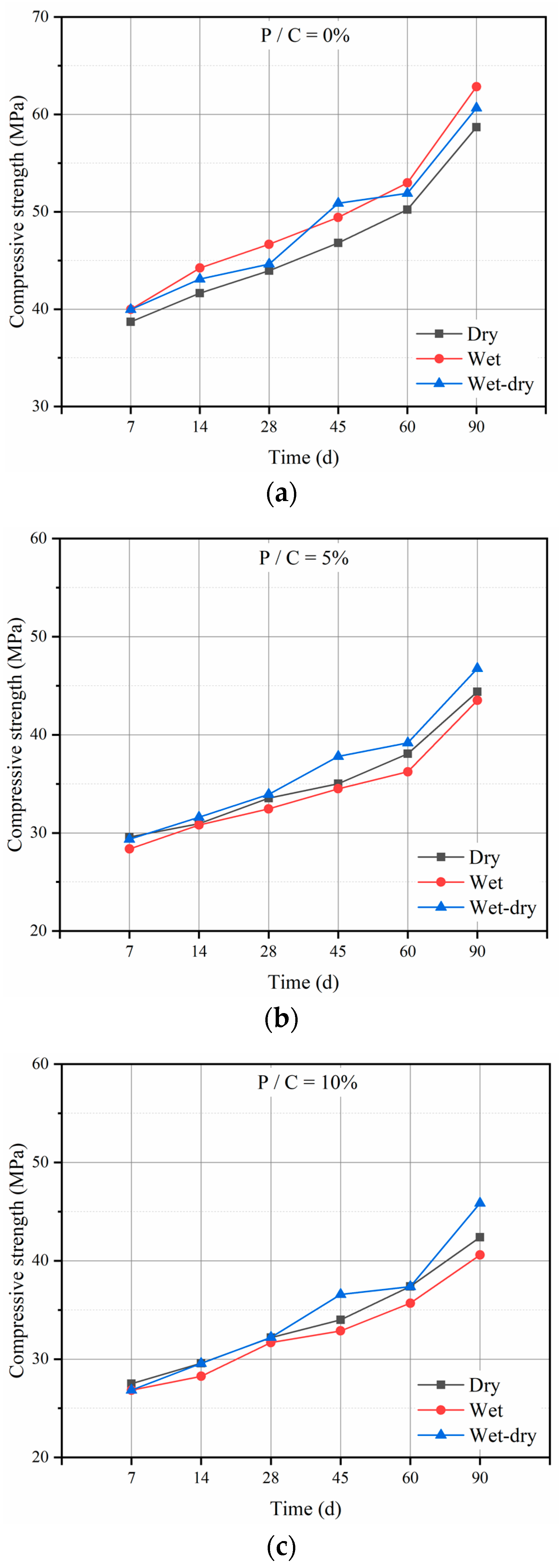
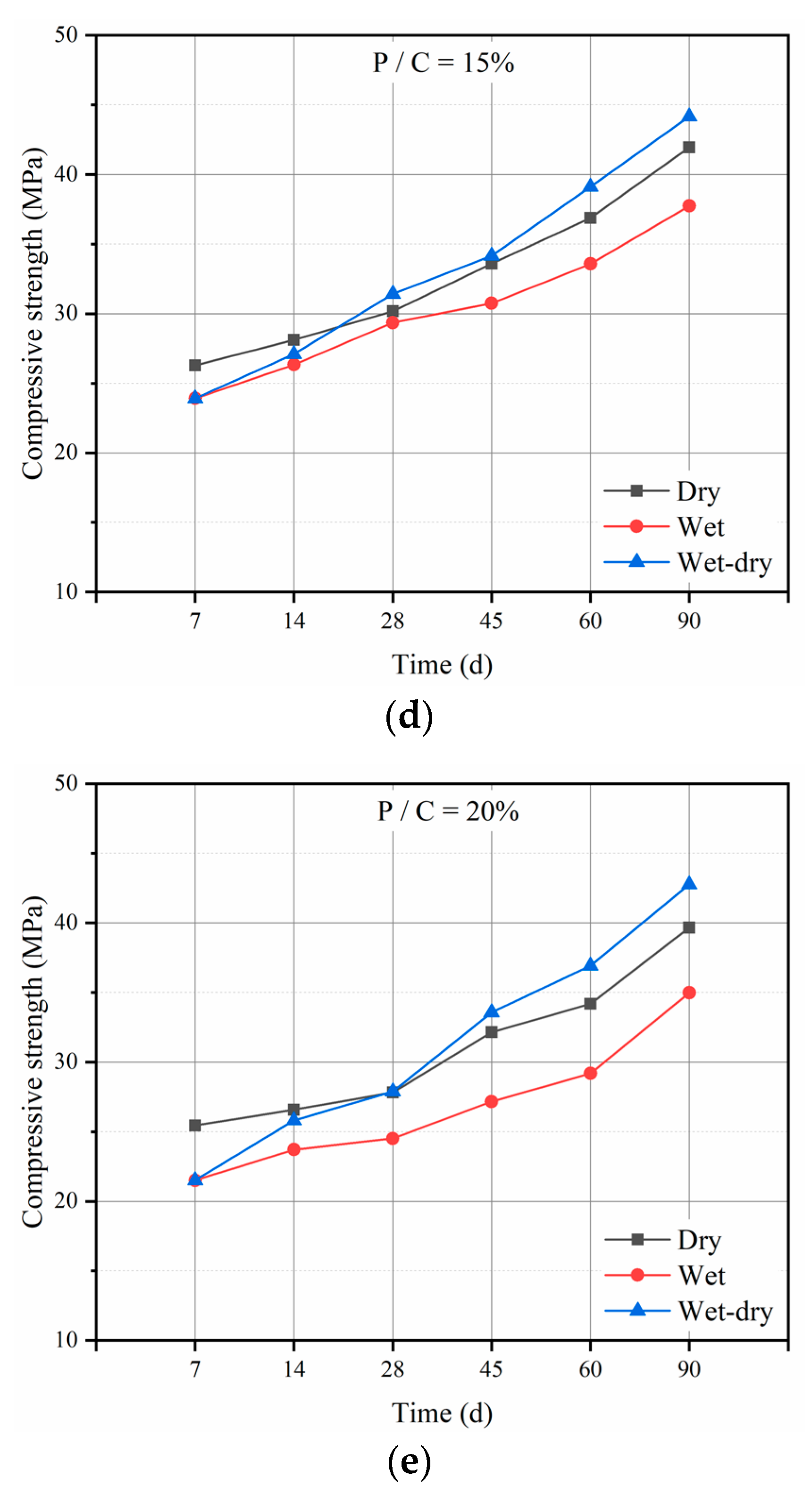
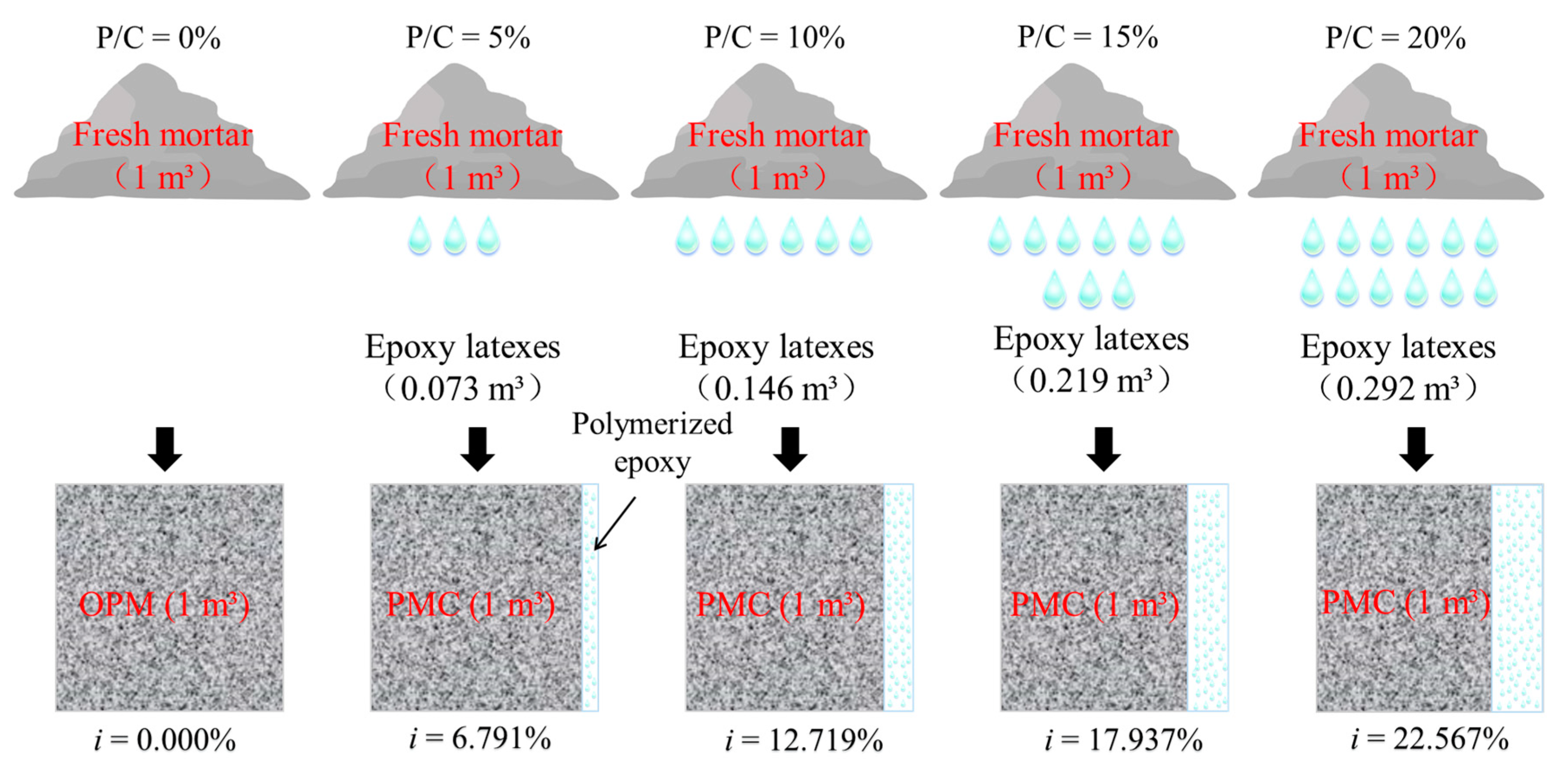

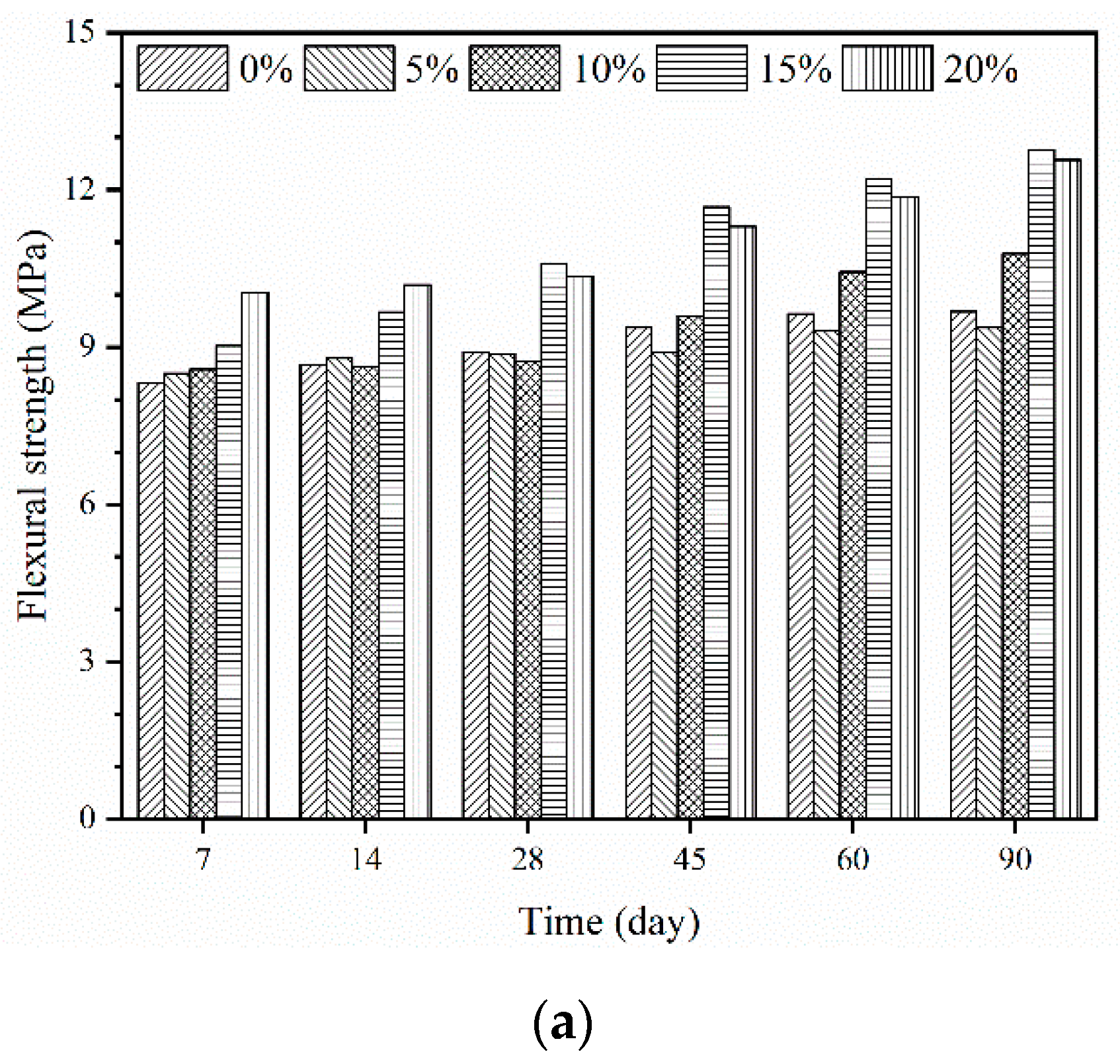

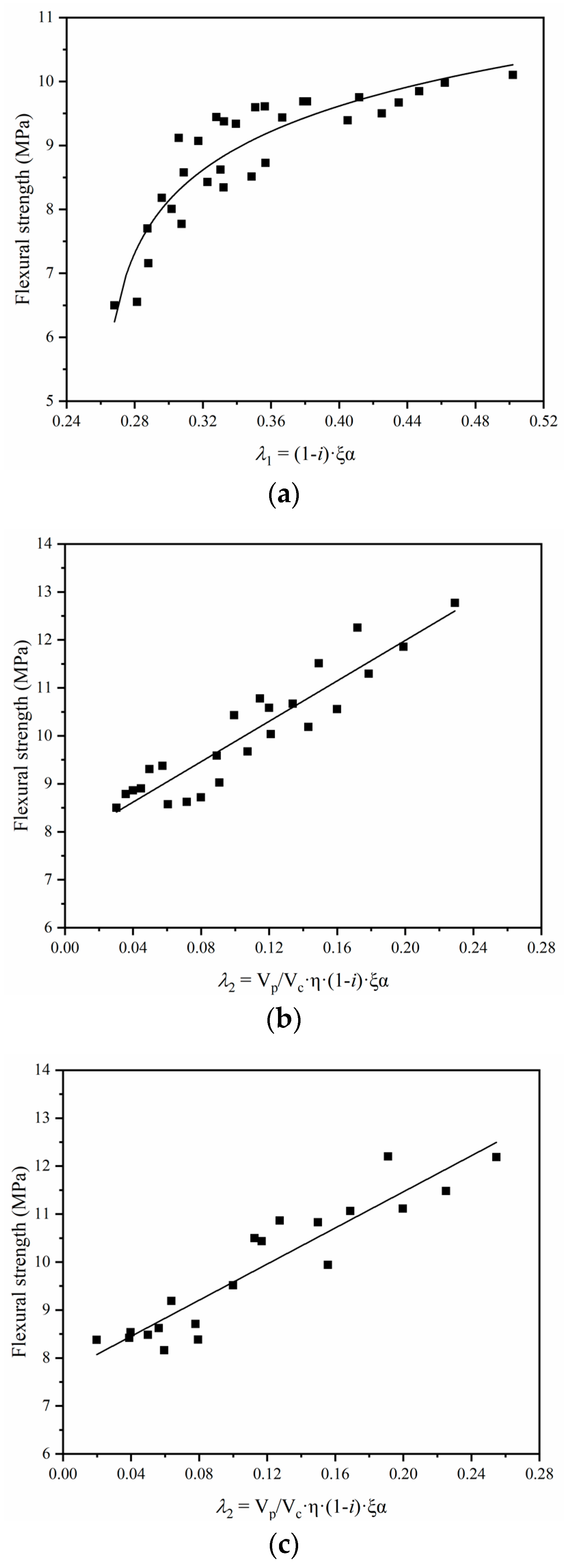

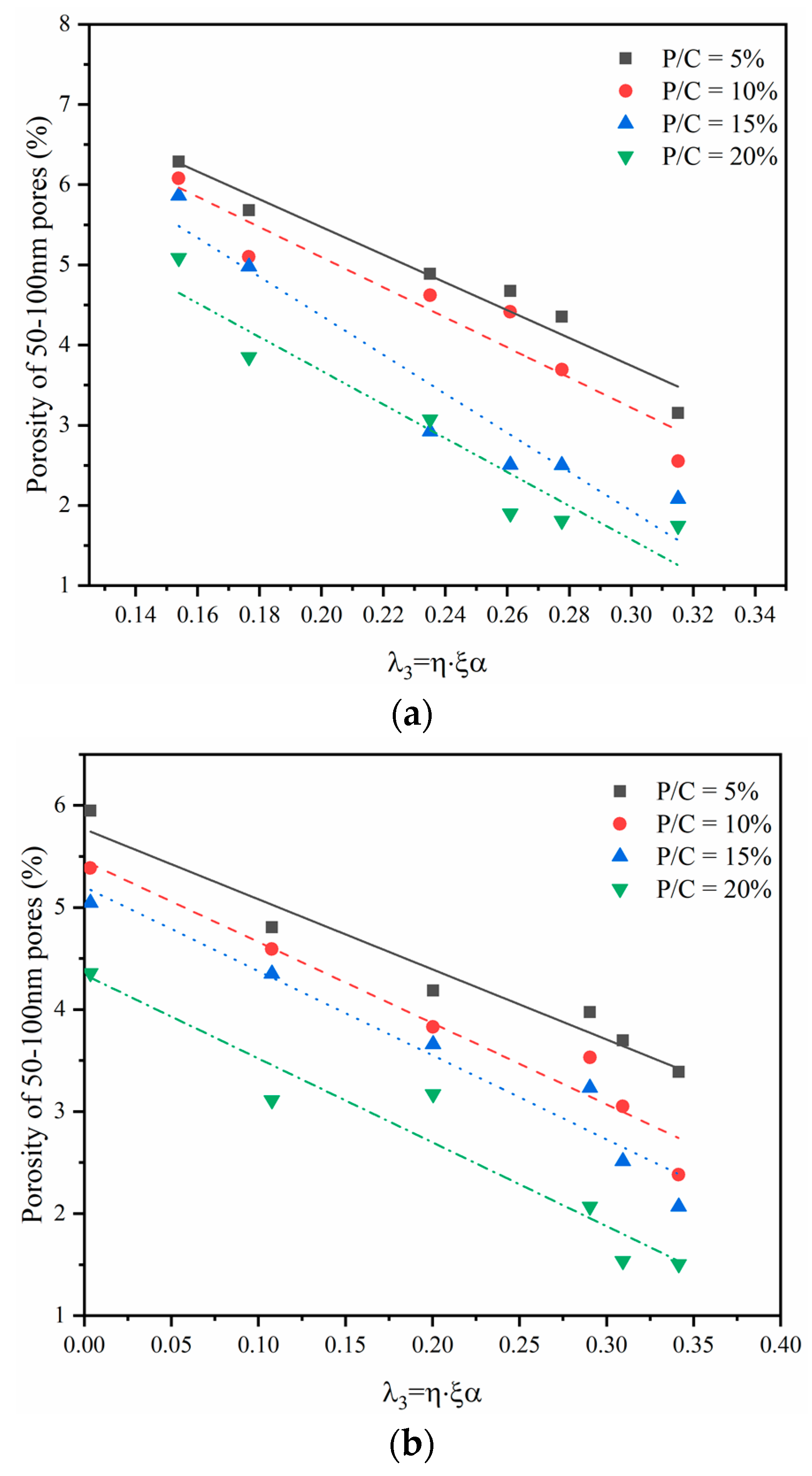
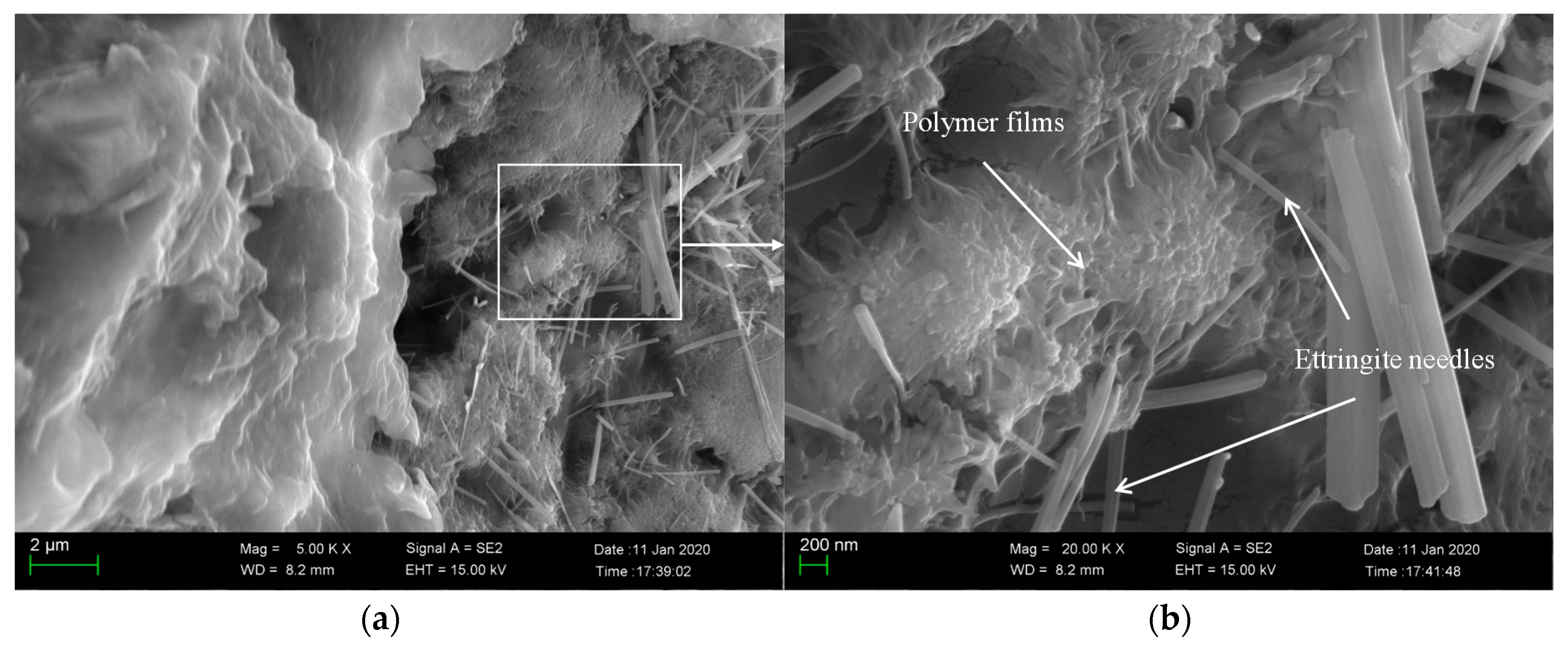
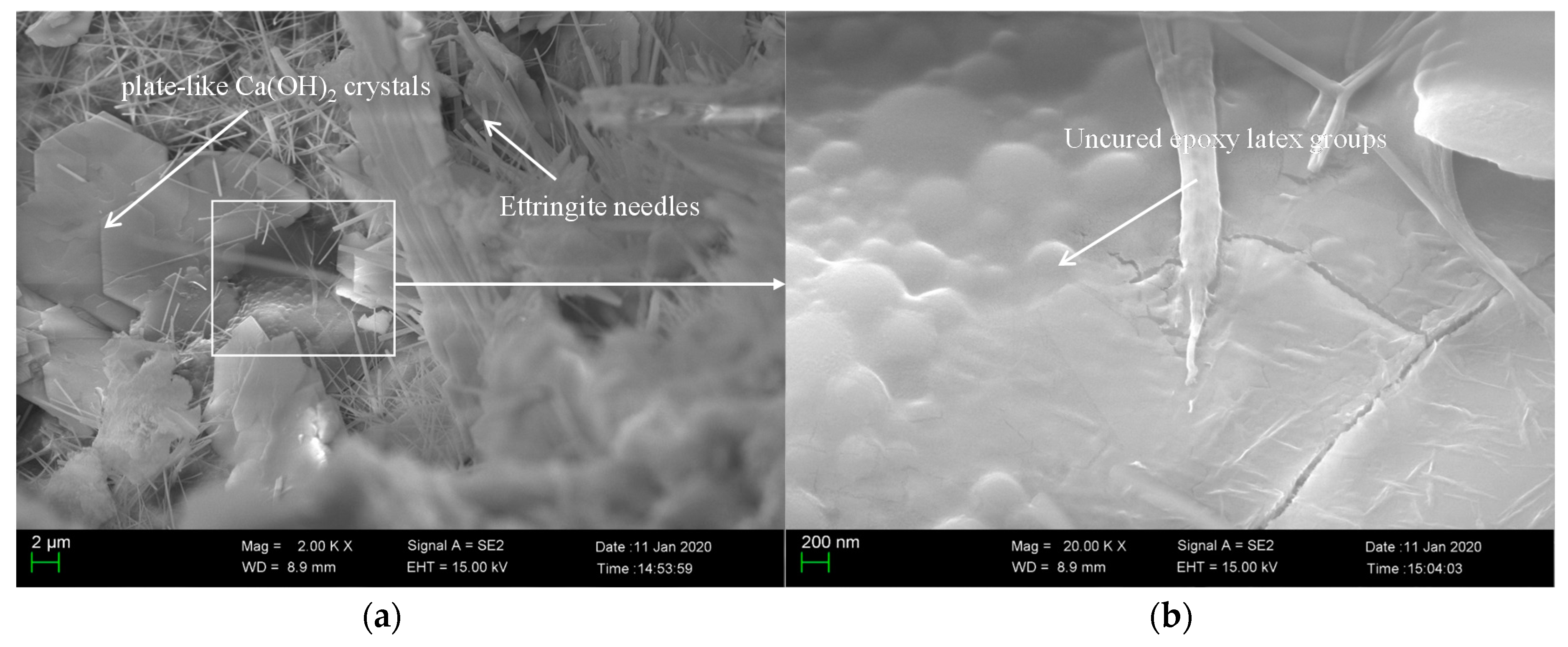
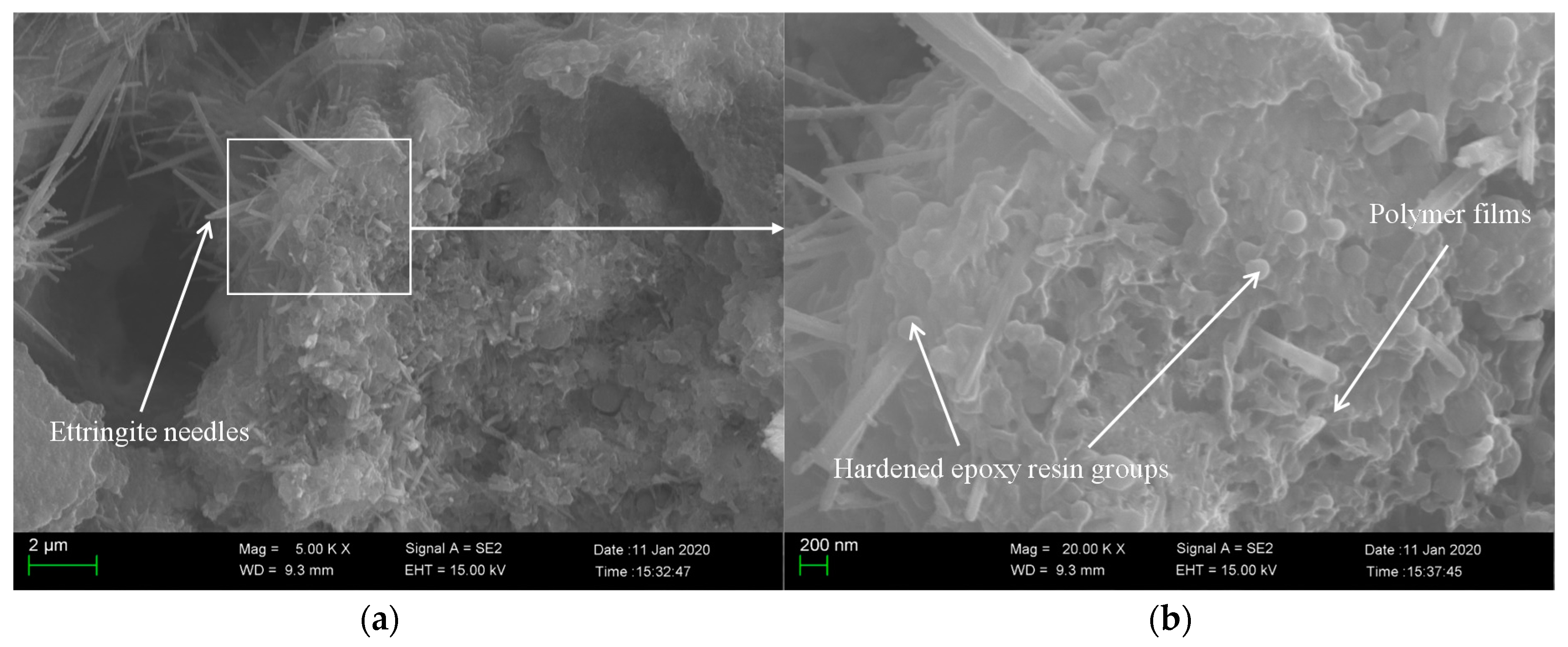
| Mix Label | Epoxy Resin | Hardener | Water |
|---|---|---|---|
| epoxy emulsion | 28.57 | 42.86 | 28.57 |
| Mix Label | Vw/Vc | SP% | P/C | L/C | C | S | W | AD | ER | H |
|---|---|---|---|---|---|---|---|---|---|---|
| Control | 1.1 | 1.4 | 0% | 0% | 832.69 | 1199.80 | 281.46 | 11.66 | 0 | 0 |
| Latex 1 | 1.1 | 1.4 | 5% | 8.7% | 832.69 | 1199.80 | 281.46 | 11.66 | 41.63 | 31.23 |
| Latex 2 | 1.1 | 1.4 | 10% | 17.4% | 832.69 | 1199.80 | 281.46 | 11.66 | 83.27 | 62.45 |
| Latex 3 | 1.1 | 1.4 | 15% | 26.1% | 832.69 | 1199.80 | 281.46 | 11.66 | 124.90 | 93.68 |
| Latex 4 | 1.1 | 1.4 | 20% | 34.8% | 832.69 | 1199.80 | 281.46 | 11.66 | 166.54 | 124.90 |
| Curing Regimes | 7 d | 14 d | 28 d | 45 d | 60 d | 90 d | |
|---|---|---|---|---|---|---|---|
| α | Wet | 0.405 | 0.425 | 0.435 | 0.447 | 0.462 | 0.502 |
| Dry | 0.400 | 0.413 | 0.423 | 0.436 | 0.451 | 0.485 | |
| Wet–dry | 0.405 | 0.420 | 0.426 | 0.453 | 0.458 | 0.493 |
| P/C | 5% | 10% | 15% | 20% |
|---|---|---|---|---|
| i | 6.791% | 12.719% | 17.937% | 22.567% |
| P/C | ξ | 7 d | 14 d | 28 d | 45 d | 60 d | 90 d | |
|---|---|---|---|---|---|---|---|---|
| 0% | 1.000 | α | 0.405 | 0.425 | 0.435 | 0.447 | 0.462 | 0.502 |
| 5% | 0.880 | α’ = ξα | 0.356 | 0.374 | 0.383 | 0.393 | 0.407 | 0.442 |
| Predicted (MPa) | 28.10 | 31.21 | 32.82 | 34.79 | 37.31 | 44.37 | ||
| Experimental (MPa) | 28.36 | 30.80 | 32.45 | 34.50 | 36.23 | 43.51 | ||
| Model absolute error | 0.92% | 1.33% | 1.14% | 0.84% | 2.98% | 1.98% | ||
| 10% | 0.870 | α’=ξα | 0.352 | 0.370 | 0.378 | 0.389 | 0.402 | 0.437 |
| Predicted (MPa) | 26.25 | 29.16 | 30.66 | 32.50 | 34.85 | 41.45 | ||
| Experimental (MPa) | 26.84 | 28.25 | 31.68 | 32.87 | 35.69 | 40.59 | ||
| Model absolute error | 2.20% | 3.22% | 3.22% | 1.13% | 2.35% | 2.12% | ||
| 15% | 0.865 | α’=ξα | 0.350 | 0.368 | 0.376 | 0.387 | 0.400 | 0.434 |
| Predicted (MPa) | 24.31 | 27.00 | 28.39 | 30.09 | 32.28 | 38.38 | ||
| Experimental (MPa) | 23.91 | 26.33 | 29.36 | 30.75 | 33.57 | 37.74 | ||
| Model absolute error | 1.67% | 2.54% | 3.30% | 2.15% | 3.84% | 1.70% | ||
| 20% | 0.855 | α’ = ξα | 0.346 | 0.363 | 0.372 | 0.382 | 0.395 | 0.429 |
| Predicted (MPa) | 21.82 | 24.23 | 25.48 | 27.01 | 28.97 | 34.45 | ||
| Experimental (MPa) | 21.50 | 23.71 | 24.51 | 27.16 | 29.19 | 34.98 | ||
| Model absolute error | 1.49% | 2.19% | 3.96% | 0.55% | 0.75% | 1.52% |
| Curing Regimes | 7 d | 14 d | 28 d | 45 d | 60 d | 90 d | |
|---|---|---|---|---|---|---|---|
| η | Wet | 0 | 0 | 0 | 0 | 0 | 0 |
| Dry | 0.450 | 0.500 | 0.650 | 0.700 | 0.720 | 0.760 | |
| Wet–dry | 0 | 0.300 | 0.550 | 0.750 | 0.790 | 0.810 |
Publisher’s Note: MDPI stays neutral with regard to jurisdictional claims in published maps and institutional affiliations. |
© 2021 by the authors. Licensee MDPI, Basel, Switzerland. This article is an open access article distributed under the terms and conditions of the Creative Commons Attribution (CC BY) license (http://creativecommons.org/licenses/by/4.0/).
Share and Cite
Li, P.; Lu, W.; An, X.; Zhou, L.; Du, S. Effect of Epoxy Latexes on the Mechanical Behavior and Porosity Property of Cement Mortar with Different Degrees of Hydration and Polymerization. Materials 2021, 14, 517. https://doi.org/10.3390/ma14030517
Li P, Lu W, An X, Zhou L, Du S. Effect of Epoxy Latexes on the Mechanical Behavior and Porosity Property of Cement Mortar with Different Degrees of Hydration and Polymerization. Materials. 2021; 14(3):517. https://doi.org/10.3390/ma14030517
Chicago/Turabian StyleLi, Pengfei, Wei Lu, Xuehui An, Li Zhou, and Sanlin Du. 2021. "Effect of Epoxy Latexes on the Mechanical Behavior and Porosity Property of Cement Mortar with Different Degrees of Hydration and Polymerization" Materials 14, no. 3: 517. https://doi.org/10.3390/ma14030517






